Effect of Mineral and Vitamin Supplementation on Performance and Haemotological Values in Broilers
Pervez Ahmed Khoso, Aziz Ahmed Memon, Ali Asghar Baloch, Ali Raza Mangi, and Zafar Ali Khoso
1 Department of Veterinary Medicine, Shaheed Benazir Bhutto University of Veterinary and Animal Sciences Sakrand, Sindh, Pakistan
2 Department of Poultry Husbandry, Sindh Agricultural University, Tando Jam, Pakistan
3 Department of Veterinary Pathology, Shaheed Benazir Bhutto University of Veterinary and Animal Sciences Sakrand, Sindh, Pakistan
4 Department of Veterinary Anatomy and Histology, Shaheed Benazir Bhutto University of Veterinary and Animal Sciences Sakrand, Sindh, Pakistan
5 Department of Animal Breeding, Shaheed Benazir Bhutto University of Veterinary and Animal Sciences Sakrand, Sindh, Pakistan
Introduction
Cost of the feed covers about 70% of the total cost of production in most poultry production enterprises.Hence, a slight fluctuation in the feed cost can affect the total cost of operation.The composition of major animal protein ingredients is too variable to be dependable.So, use of plant proteins in diet formulation is inevitable.However, formulating diets using sole plant protein ingredients are not probably possible because most of the plant proteins are deficient in minerals and vitamins needed for proper broiler growth (Hanet al., 1992).
Minerals and vitamins play vital role in broiler production in relation to their health and subsequent quality meat production, vitamins are nutrients that regulate the biochemical reactions by which energy and protein are used for health, growth,feed conversion meat and egg production.Without vitamins these biochemical reactions will not occur and the nutrients present in feed will not be properly utilized.Among organic compounds, vitamins have special function, and are mandatory in small amounts in the diet to maintain body physiological function,development of body structure and body growth.
Vitamins help in metabolism, nutrient utilization and prevent clinical deficiencies.Under commercial conditions, dietary nutrients are considered adequate when economic parameters, such as growth and reproduction are adequately taken care.Through research into the biological mechanisms of vitamin action, it has now been established that substantially higher intake of some vitamins may significantly influence the immune process in chickens (Siddique,2004).
Vitamins and minerals are made of two different compounds, vitamins are produced from plants and animals and minerals come from the soil and water.Calcium and other minerals are required in larger amount for normal growth and health status of animals; meanwhile, other trace elements chromium,copper, iodine, iron, selenium and zinc are required in small amount each day to animals.Hence, vitamins and minerals support normal growth and development,help cell for their proper function and boost the immune system (McMullin, 2009).
Although dietary vitamin and mineral requirements for birds have been periodically reestablished (NRC,1984), some aspects of these requirements are continuously questioned.The requirements are normally determined in young birds by using highly purified diets and in thermo neutral conditions; however, the actual requirement can be quite different in poultry production systems, as the birds are subjected to stressful situations that can be avoided during experimental trials.Rutzet al.(1999) reported the effect of vitamin or mineral withdrawal during the finisher period on the performance of broiler chickens.Considering the above hypothesis, an experiment was conducted to determine the productive and hematological changes in broilers by combined feed supplementation of minerals and vitamins.
Materials and Methods
Preparation of animals
Immediately after arrival, chicks were weighted for observation on initial body weight.Four different groups viz A, B, C and D were arranged randomly,each group comprised of 30 chicks.All the chicks were reared up to 42 days on commercial feed.One drinker and one feeder were provided to each group of broiler.The 24 h lighting was provided throughout the trail.Two inches litter was spread in each group.
Initial brooding temperature was 32℃ and final temperature was 21℃ N.D, I.B.D and H.P.S vaccines were administered as recommended by Pakistan Poultry Association.The commercial crumble feed was given to all the experimental birds.Feed and water offered on daily basis and refusal was recorded in morning and evening with daily basis.
Treatment of animals
A commercial product "Aquavit Electrolyte" was used as source of vitamin and mineral supplementation at the rate of 5 g · 10 L-1of water.The chicks in group A were kept as the control (without mineral and vitamin supplementation), group B was treated with Aquavit Electrolytes (Vit.A 12 MIU, Vit.D32 IU,Vit.E 4 000 IU, Vit.K34 000 mg, Vit.B23 000 mg,Vit.C 5 000 mg, calcium pantothenate 1 000 mg,folic acid 500 mg, biotin 10 mg, potassium 4 000 mg,copper 15 mg, sodium 1 000 mg and chlorine 2 000 mg)at the rate of 5 g · 10 L-1water for in group C first 4 weeks, and group D lasted 2 weeks (4 to 6 weeks of experiment).Daily feed and water intake, mortality and weekly live body weight were recorded.At the end of trail hematological values, carcass and organs weight were recorded and economics were calculated.
Statistical analysis
The data thus collected were tabulated, fed to the computer using Statistix Ver.8, Statistical Computer Package under General Linear Model and analyzed for significance of differences between treatment means through analysis of variance technique; while LSD test was perform to compare the means for significance of differences between the means of broiler groups.
Results
Feed and water consumption
经食管超声心动图右心声学造影与对比增强TCD检查在检测隐源性脑卒中患者右向左分流的效果比较 ………………………………………… 谢坚,王玉凯,彭伟英,等 341
The highest feed intake (4 234.61 g · b-1) was recorded in group A (control) given no mineral and vitamin supplementation, while the lowest feed consumption(4 028.38 g · b-1) was recorded for broilers of group B given mineral and vitamin supplementation for whole experimental period of 6 weeks (Table 1, Fig.1).Similarly, the highest water intake (9 882.11 L · b-1)was recorded in group C, given mineral and vitamin supplementation for first 4 weeks, while the lowest water intake (9 295.55 L · b-1) was recorded for broilers group B given mineral and vitamin supplementation for the whole experimental period of 6 weeks.

Table 1 Average feed and water consumption of broilers as in fluenced by various regimes of mineral and vitamin supplementation

Fig.1 Average feed (g) and water (mL) consumption of broilers as influenced by various regimes of mineral and vitamin supplementation
Live body weight, feed conversion ratio,carcass weight and dressing percentage
The live body weight was the highest 2 360.90 g · b-1in group B broilers given mineral and vitamin supplementation for 6 weeks, while the lowest live body weight(2 068.90 g · b-1) was recorded in the control group, where mineral and vitamin was not supplemented.The feed efficiency was better (1.71) in group B broilers, while the lowest feed conversion ratio of 2.05 was recorded in the control group.The carcass weight and dressing percentage was markedly the highest (1 656 g · b-1)and (63.02 %) in group B, while the minimum carcass weight and dressing percentage of 1 528.8 g · b-1and(60.51%) was recorded in group D (Table 2, Fig.2).
Organ weight
The weight of heart of randomly selected slaughtered broilers after 6 weeks was higher in groups A, B, C and D, and was 15.13, 13.16, 11.72 and 11.50 g · b-1,weight of gizzard was 32.98, 37.48, 37.62 and 33.35,weight of liver was 51.94, 48.70, 51.94 and 48.70 g · b-1and spleen weight was 3.48, 3.28, 3.06 and 2.82 g · b-1,respectively (Table 3, Fig.3).
Hematological values and mortality
Haemoglobin level in blood was significantly higher(12.23 g · dL-1) in broiler group B, where minerals and vitamins were supplemented throughout the experimental period of 42 days, while the lowest haemoglobin level in blood count of 7.60 g · dL-1was determined in group D, where mineral and vitamin supplementation was given only for last 2 weeks.White blood cell (WBC) level in blood was significantly higher i.e.89.83 (×106µL) in group B,where minerals and vitamins were supplemented throughout experimental period of 6 weeks, while the lowest WBC level in blood count of 77.47 (×106µL)was determined in group A, where the minerals and vitamins were not supplemented throughout experimental period of 6 weeks.Red blood cell (RBC) level in blood was relatively higher i.e.2.58 (×106µL)in group B, while the lowest RBC level in blood count of 1.40 (×106µL) was determined in group D.Mortality was relatively higher (20.00%) in group A (control),where mineral and vitamin supplementation was not given, while the lowest mortality of 8.00% was seen in group B where the mineral and vitamin supplementation was given for 6 weeks (Table 4, Fig.4).

Table 2 Live body weight, feed conversion ratio, carcass weight and dressing percentage of broilers as in fluenced by various regimes of mineral and vitamin supplementation

Fig.2 Live body weight, feed conversion ratio, carcass weight and dressing percentage of broilers as influenced by various regimes of mineral and vitamin supplementation

Table 3 Weight of organs of broilers as influenced by various regimes of mineral and vitamin supplementation
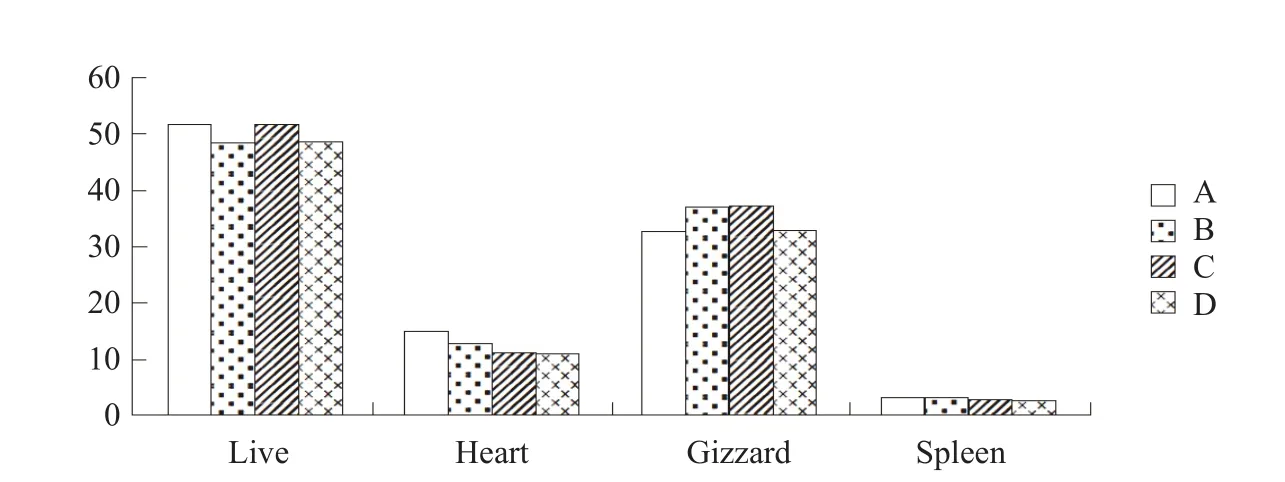
Fig.3 Weight of visceral organs as influenced by various regimes of mineral and vitamin supplementation

Table 4 Average RBC, WBC, haemoglobin level and mortality of broilers as influenced by various regimes of mineral and vitamin supplementation
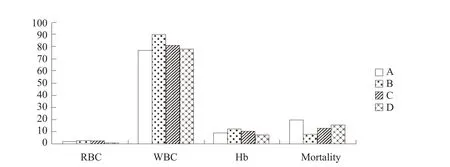
Fig.4 Average RBC, WBC, haemoglobin level and mortality of broilers as influenced by various regimes of mineral and vitamin supplementation
Economics
All the A, B, C and D groups were sold at 144.823,165.263, 157.871 and 151.018 Rs · b-1, against the total production cost of 104.749, 109.986, 109.32 and 106.728 Rs · b-1, generating the net profit of 40.0739,55.2773, 48.5512 and 44.29 Rs · b-1, respectively.
It was observed that supplementation of minerals and vitamins for whole experimental period of 42 days(group B) was remarkably more beneficial as compared to split supplementation for certain periods of the breeding and growth periods of broilers (Table 5, Fig.5).

Table 5 Economics of experimental broiler production
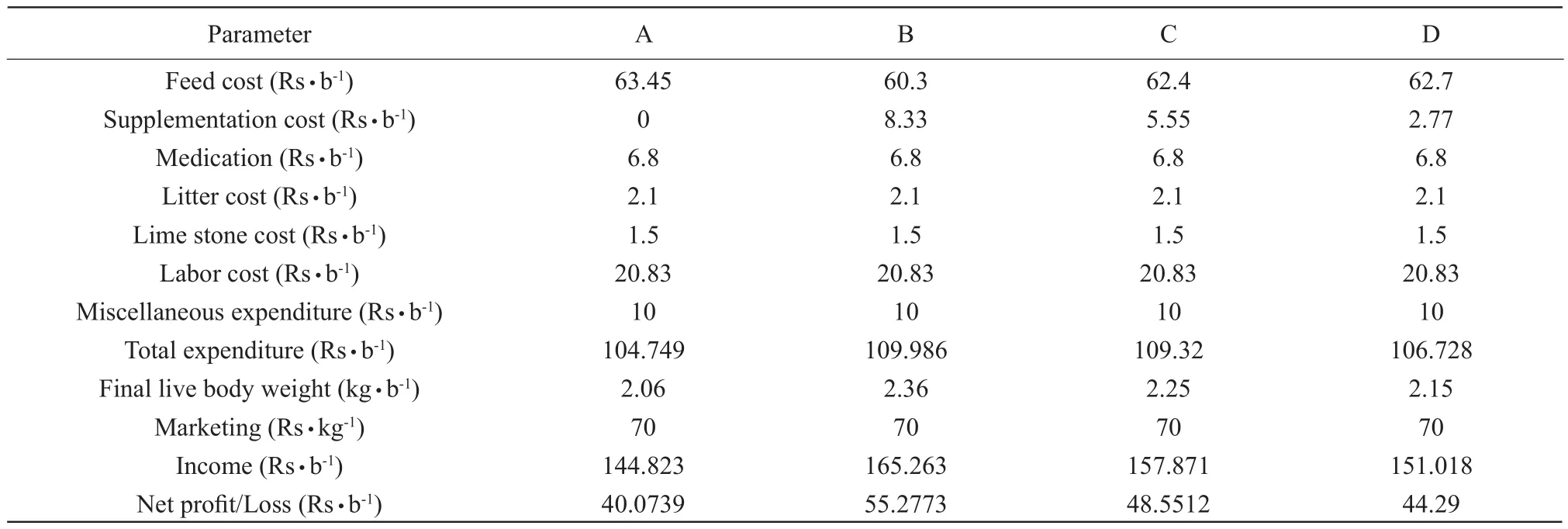
Continued
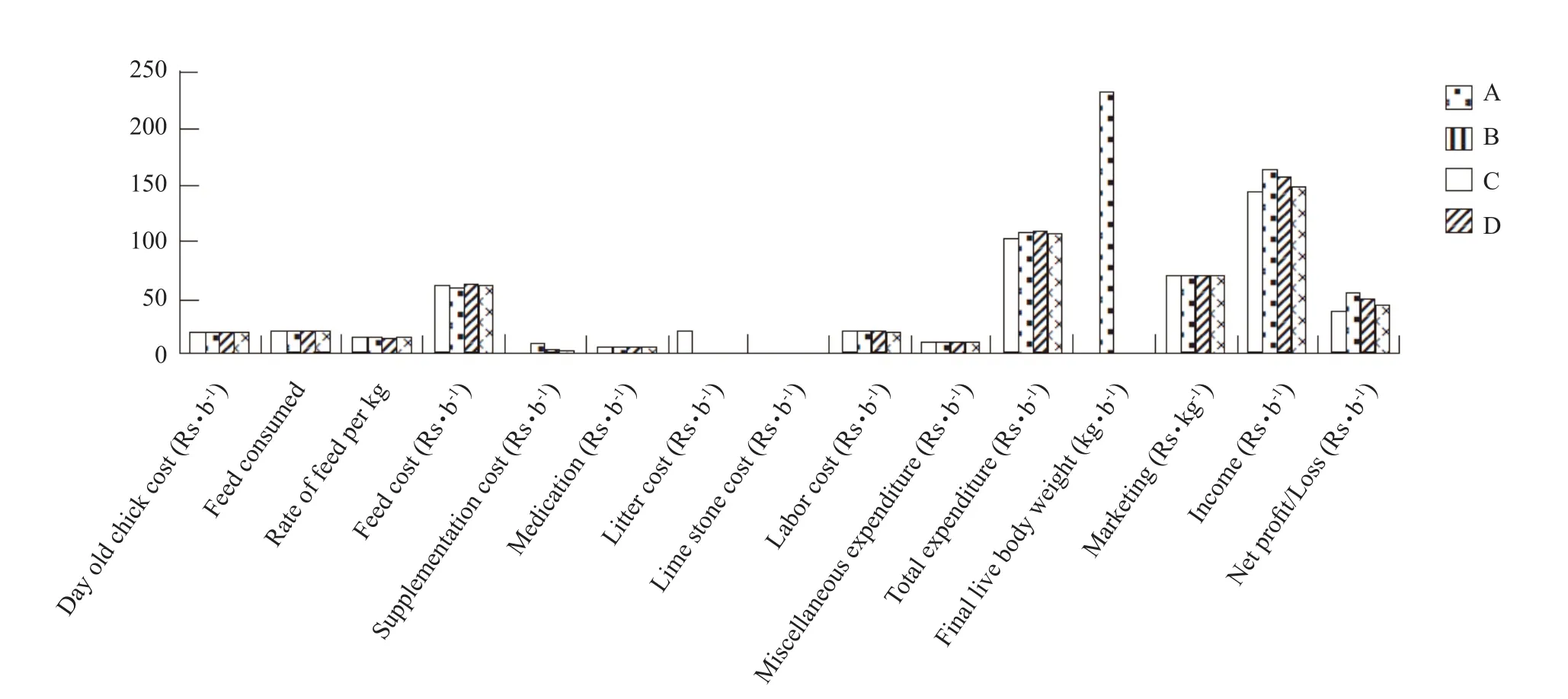
Fig.5 Economics for experimental broiler production
Discussion
The findings from the present study indicated that feed intake of broilers in groups A, B, C and D was 4 234.61,4 028.38, 4 169.32 and 4 181.87 g · b-1; water intake was 9 668.88, 9 295.55, 9 882.11 and 9 402.86 L · b-1;live body weight was 2 068.90, 2 360.90, 2 255.30 and 2 157.40 g · b-1, respectively.Similarly, Santinet al.(2002) and Jafariet al.(2005) reported that high levels of minerals and vitamins significantly increased feed intake of the chicks and suggested that the use of low levels of vitamins in broiler production did not influence the broiler performance.The ratio of feed conversion in broilers of groups A, B, C and D was 2.05, 1.71, 1.85 and 1.94, respectively.These results are partially supported by Toghyaniet al.(2006) who found considerable improvement in feed conversion efficiency of broilers when broilers were given minerals and vitamins as supplementation with their routine feed.Similarly, carcass weight in groups A,B, C and D was 1 550, 1 656, 1 552 and 1 528.8 g · b-1,which resulted average dressing percentage of 61.24%,63.02%, 62.60% and 60.51%, respectively.The present results are well in line with those of Jafariet al.(2005) who reported that feed conversion ratio was considerably improved with supplementation of minerals and vitamins in broiler feed.The weight of heart of randomly selected slaughtered broilers after 6 weeks were higher in groups A, B, C and D, and was 15.13, 13.16, 11.72 and 11.50 g · b-1, weight of gizzard 32.98, 37.48, 37.62 and 33.35, weight of liver 51.94, 48.70, 51.94 and 48.70 g · b-1and spleen weight 3.48, 3.28, 3.06 and 2.82 g · b-1, respectively.These results are in concurrence with those of Tortueroet al.(2003) who reported that there had been no effect of mineral and vitamin supplementation on weight of gizzard, liver, spleen, heart or pancreas or on length of intestine.In our study, there was no linear effect of minerals and vitamins on edible and non-edible internal organs of experimental broilers.Average mortality in groups A, B, C and D was 6, 2, 4 and 5 resulting 20.00%, 8.00%, 13.00% and 16.00%mortality rate, respectively.The haemoglobin level in blood of broilers of groups A, B, C and D was 9.20,12.23, 10.87 and 7.60 g · dL-1, WBC level was 77.47,89.83, 81.63 and 78.13 (×106µL); RBC level was 1.85,2.58, 2.45 and 1.40 (×106µL), respectively.These findings were further confirmed by Memon (2006),who reported that mineral and vitamin supplementation to broiler feed caused improvement in haemoglobin level in blood, increased counts of RBC and WBC.
Conculusions
The present investigations showed that mineral and vitamin supplementation in drinking water over full rearing period influenced better feed conversion ratio and performance of boiler chicken.
The experiments were conducted at Poultry Experiment Station, Sindh Agricultural University Tando Jam.
Conflict of interest
Authors declare that there are no conflicts of interest.
Han Y, Suzuki H, Parsons C,et al.1992.Amino acid fortification of a low protein corn and soybean meal diet for chicks.Poult Sci, 71:1168-1178.
Jafari A, Navidshad B, Abolghasemi A,et al.2005.Effects of dietary mineral premix reduction or withdrawal on broilers performance.International Journal of Poultry Science, 4: 896-899.
McMullin P.2009.Minerals and vitamin supplementation in poultry.Poultry Health Services, Eastwood Central Laboratory, USA.
Memon M.2006.Effect of biotin as feed additive on the growth of broiler.Sindh Agriculture University, Tandojam.
NRC (National Research Council).1984.Nutrient requirements of domestic animals.Nutrient requirements of poultry.8th ed.Natl Acad Sci, NRC.Washington, DC.
Rutz F, Xavier E, Dadalt G.1999.Exigências nutricionais para a fase final(energia,aminoácidos,vitaminas,minerais e aditivos).In.Conferëncia apinco de ciëncia e tecnologia avícolas, Santos.Anais.Campinas.FACTA, 32-36.
Santin E, Maiorka A, Segatto G,et al.2002.Influence of different levels of vitamins A, B6, folic acid and biotin, in broiler diets on broiler performance.Ars Veterrinaria, 16(1): 52-57.
Siddique M.2004.Role of vitamins in immune response in poultry.Department of Vet.Microbiology.Univ.of Agricultrue, Faisalabad.Pakissan.pp.1-3.
Toghyani M, Shivazad M, Gheisari A,et al.2006.Performance, carcass traits and hematological; arameters of broiler chicks in response to dietary levels of vitamin and minerals.International Journal of Poultry Science, 5(1): 65-69.
Tortuero F, Fernandez E, Martin L.2003.Effects of dietary minerals and vitamins on the growth, visceral measurements and food passage in chickens.Archivos de Zootecnia, 41: 209-217.
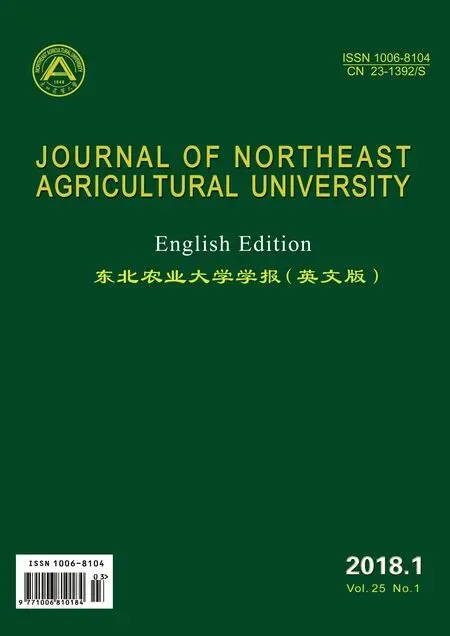 Journal of Northeast Agricultural University(English Edition)2018年1期
Journal of Northeast Agricultural University(English Edition)2018年1期
- Journal of Northeast Agricultural University(English Edition)的其它文章
- Effect of Inoculation Rhizobium and Response of Soybean-Rhizobium System to Insoluble Phosphate
- Characteristics and Degradation Mechanism of Fomesafen
- Comparative Study of Proximate, Chemical and Physicochemical Properties of Less Explored Tropical Leafy Vegetables
- A Comparative Study on Photosynthetic Characteristics of Dryopteris fragrans and Associated Plants in Wudalianchi City, Heilongjiang Province, China
- Comparative Research on Facultative Anaerobic Cellulose Decomposing Bacteria Screened from Soil and Rumen Content and Diet of Dairy Cow
- Pharmacokinetics of Milbemycin Oxime in Dogs Following Its Intravenous and Oral Administration
